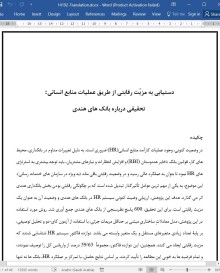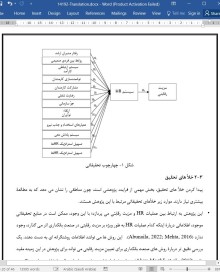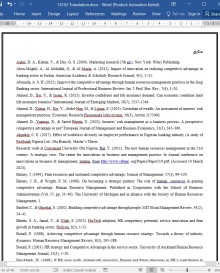
دانلود مقاله دستیابی به مزیت رقابتی از طریق عملیات منابع انسانی
چکیده
در وضعیت کنونی، وجود عملیات کارآمد منابع انسانی(HR) ضروری است. به دلیل تغییرات مداوم در بانکداری، محیط های کار، قوانین بانک ذخایر هندوستان(RBI) و افزایش انتظارات و نیازهای مشتریان، باید توجه بیشتری به استرتژی هایHR نمود تا بتوان به عملکرد عالی رسید و در وضعیت رقابتی باقی ماند (به ویژه در سازمان های خدمات رسانی). این موضوع، به یکی از مهم ترین عوامل تأثیرگذار تبدیل شده است که بر چگونگیِ رقابتی بودنِ بخش بانکداری هندی اثر می گذارد. هدف این پژوهش، ارزیابیِ وضیت کنونیِ سیستمHR در بانک های هندی و وضعیت آن به عنوان یک مزیت رقابتی است. برای این تحقیق،600 پاسخِ نظرسنجی از بانک های هندی جمع آوری شد. روش مورد استفاده در این پژوهش، مدل معادلاتِ ساختاریِ مبتنی بر حداقل مربعات جزئی، با استفاده از آزمون کای-دو و تحلیل توصیفی، بر پایۀ تعداد زیادی متغیرهای مستقل و یک متغیر وابسته می باشد. دوازده فاکتورِ سیستم HR شناسایی شدند که مزیت رقابتی ایجاد می کنند. همچنین، این دوازده فاکتور، مجموعاً 59/63 درصد از واریانس کل را توصیف نمودند، و تمام فرضیه ها به خوبی این مطالعه را تأیید کردند. بر اساس نتایج حاصل، با تمرکز بر عملکرد HR، بانک ها نه تنها می توانند در این شرایط اقتصادی دشوار، بقا یابند، بلکه به مزیت رقابتی هم دست می یابند. در سیستم هایHR مورد استفاده توسط بانک ها و مزیت رقابتی که به آن دست یافته اند، تغییرات بین-بخشی وجود دارند که لازم است که با برنامه ریزی دقیقی حفظ شوند.
1. مقدمه
در این شرایط پویا و دشوار، سطح بالاتری از کیفیت مورد نیاز است. هم اکنون،HR نقش استراتژیکی ایفا می کند. سناریو عوض شده است و اساس مزیت رقابتیِ بلندمدت به میزان چشمگیری از امور مالی به سمت فن آوری و مزیت HR-محور تغییر کرده است. ایجاد منبعی که بتواند به عنوان ابزار کلیدی برای موفقیت سازمان عمل کند، امری حیاتی است. برای موفق شدن در این وضعیت پویا و رقابتی که فشار زیادی به تجارت ها وارد می کند، باید روی غیرقابل جایگزین ترین منبعِ مزیت رقابتی، یعنی مردم، سرمایه گذاری نمود.
بانک ها عمدتاً بر نتایج مالی تمرکز دارند. سناریو تغییر کرده است و تغییر قابل توجهی از امور مالی به سمت فن آوری و HR ایجاد شده است. زمانی رسیده است که بانک ها باید روش های قدرتمندی را برای مواجهه با چالش های بحرانی به کار گیرند و در محیط رقابتیِ کنونی، عملکرد عالی داشته باشند . اکنون، این صنعت خدمات رسانی برای برآورده ساختن نیازهای مشتریان، به مهارت های نرم، بیشتر از مهارت های اجرایی نیاز دارد. هم اکنون، کسی نمی تواند با استفاده از عملیات رایجِHR به سمت جلو حرکت کند. بانک ها باید دپارتمانHR خود را بهبود بخشند و به خوبی بشناسند تا بتوانند در این محیط پیچیده و متغیّر دوام بیاورند و انتظارات مشتریان را برآورده سازند. با توجه به اهمیت موضوع، در این پژوهش این امر مورد تحلیل و بررسی قرار گرفت که چگونه سیستم HR سبب رسیدن به مزیّت رقابتی می شود.
باارزش ترین منبع برای هر تجارت،HRM آن است، چون تمام استراتژی ها را اجرا می کند. هر سازمان، سعی دارد با پیشرفت فن آوری، کاهش هزینه ها، افزایش کیفیت، و روش های دیگر، به مزیّت رقابتی دست یابد. ولی این موارد فقط تا حدّ خاصی می توانند عملکرد اجراییِ یک شرکت را بهبود بخشند. یک تجارت باید بر مهم ترین منبع خود یعنیHR تمرکز نماید تا بتواند از این مرحله عبور کند. وقتی یک شرکت، یک استراتژی ارزش آفرینی اجرا نماید که رقبایش برای دستیابی به مزایا از آن استفاده نمی کنند و آن را کپی نمی کنند، یعنی به یک مزیت رقابتی دست یافته است(Barney, 1991) .
6. نتیجه گیری ها، محدودیت ها، و مسیر تحقیقات آتی
به طور کلی، دستیابی به مزیت رقابتی از طریق عملیات منابع انسانی، امری ضروری در موفقیّت سازمان است و این امر در مورد بانک های هندی نیز صدق می کند. عملیاتHR می توانند نقش حیاتی در ایجاد فرهنگ سازمانی، بهبود مشارکت کارمندان، و افزایش بهره وری داشته باشند. بانک ها با استفاده از بهترین عملیات HR، می توانند کارمندانِ با استعداد را جذب و حفظ کنند، نیروی کار ماهری بسازند، و رضایت مشتریان را افزایش دهند. برخی از عملیاتHR که بانک ها می توانند از آنها استفاده نمایند عبارتند از سیستم های کارآمدِ مدیریت عملکرد، برنامه های آموزش و پرورش کارمندان، ساختار منصفانه برای حقوق و مزایا، ابتکارات مربوط به مشارکت کارمندان، و تمرکز قوی بر پذیرش همۀ افراد و عدم تبعیض نژادی. در نتیجه، بانک های هندی، با ایجاد روش های کارآمد HR که محیط کار سالمی ایجاد کنند و افراد را برای رسیدن به بهترین عملکرد تشویق نمایند، می توانند به مزیت رقابتی دست یابند. بنابراین، بانک ها قادر خواهند بود به میزان بیشتری از رضایت مشتریان برسند، شهرت و اعتبار مثبتی ایجاد نمایند، و تجارت خود را گسترش دهند.
تمرکز این پژوهش فقط روی شش بانکِ برترِ هندی در دهلی و منطقۀ پایتختی ملّی است. 600 نفر از پرسنل در سطح 1 یا بالاترِ بانک-آفیسر (یا دستیار مدیر) نمونۀ تحقیق را تشکیل دادند. نتایجِ به دست آمده، در ارتباط با پارامترهای شناسایی شده و نیز با ارجاع به دامنۀ جغرافیایی وسیع تر و ُبانک ها یا کارمندان بیشتر، تعمیم داده شدند. محدودیت ها، محدویت های زمانی، و محدودیت های مالی، همگی بر نتایج این پژوهش اثر می گذارند. برای بهبود موضوع و نتایج تحقیق، باید تعمیم پذیری و اهمیت درک عملیاتHR در ملیّت های نوظهور مانند هندوستان را مورد بحث قرار داد. باید توجه داشت که تمرکز منطقه ایِ این پژوهش در دهلی وNCR است. با اینکه که تحلیل داده ها و نتایج، مربوط به این منطقۀ خاص هستند، ولی عوامل فرهنگی، اقتصادی، و عوامل زمینه ای ممکن است تعمیم پذیری آنها به مناطق دیگر هندوستان یا کشورهای دیگر که ویژگی های اقتصادی مشابه دارند را محدود سازند. تحقیقات بعدی می توانند با انجام تحلیل های مقایسه ای یا با تمرکز بر مناطق جغرافیایی متنوع تر، تعمیم پذیری نتایج به مناطق دیگر را بررسی نمایند. با این کار، نتیجه گیری ها و پیشنهادات کلی تری حاصل می گردد. این تحقیق نشان می دهد که درک عملیاتHR چقدر در توسعۀ ملیت ها (به دلیل فرصت ها و مشکلات ویژه ای که این شرایط ایجاد می کنند) اهمیت دارد. برای در نظر گرفتن پویایی های متغیر در مناطق مختلف، روش هایHR باید تغییر کنند. در کشورهای نوظهور، هنجارهای اجتماعی و جوانب فرهنگی نیز در مدیریتHR مهم هستند. برای بررسی چگونگیِ تأثیرِ این متغیرها بر روش هایHR باید تحقیقات بیشتری انجام شود. این یافته ها می توانند عملیاتHR را در راستای رشد اقتصادی و استفاده در گروه های تجاری، برنامه های دولتی، و مؤسسات آموزشی در ملیّت های نوظهور، بهبود بخشند.
Abstract
The current situation calls for effective Human Resource (HR) operations. In order to perform well and remain competitive, especially in service organizations, HR strategies must be given more attention due to ongoing changes in banking, the workplace, Reserve Bank of India (RBI) rules, and rising consumer wants and expectations. It has grown to be one of the most significant differentiators that has an impact on how competitive the Indian banking sector is. The study seeks to assess the current state of the Indian banks' HR system and its status as a competitive advantage. For the final study, a total of 600 replies from Indian banks were gathered. The methodology utilized in the study is partial least-squares structural equation modeling using the Chi-Square test and descriptive analysis, which is based on a large number of independent variables and one dependent variable. There are twelve HR system factors identified that lead to competitive advantage status. Further, these twelve factors collectively explained 63.59 percent of the total variance have been retrieved and all hypotheses lent good support to this study. By concentrating on the HR function, banks can not only survive in this cutthroat economic environment but also obtain a competitive advantage, according to the study's conclusions. There are intersectional variations in the HR systems used by banks and the competitive advantage status they have attained and it is needed to maintain fine-tuning.
1. Introduction
A higher level of quality is required in this dynamic and difficult time. HRs now play a strategic role. The scenario has changed, and the basis of long-term competitive advantage has significantly changed from financial to technology to HR-based. It’s critical to locate a resource that can act as a key tool for the achievement of the organization. To succeed in this dynamic and competitive climate where pressure is at an all-time high, one must invest in the most irreplaceable source of competitive advantage, namely people.
Banks mainly focus on the financial results and the scenario has changed and a drastic shift is there from financial to technological to HR. The time has come when banks have to take strong measures to face critical challenges and perform well in the current competitive environment. This service industry now demands more soft skills than operational skills as they have to attend to the needs of the customers. Now one cannot move forward by using conventional HR practices. Banks must improve and reorganize their HR department in order to survive in this complicated, changing environment and to satisfy the expectations of consumers. Considering the importance of this issue, an attempt has been made to analyze how the HR system can lead to a competitive advantage.
The most valuable resource for every business is its HRM because it carries out all of the strategies. By advancing technology, cutting costs, raising quality, and other means, every organization strives to gain a competitive advantage. Yet only to a certain point can these improve the operating performance of the firm. The business must concentrate on its most valuable resource, which is its HR, in order to move past that stage. If a company implements a value-creating strategy that is not being used by its rivals and is not being copied by them in order to reap the benefits of the strategy, it will have a competitive advantage (Barney, 1991).
6. Conclusions, limitations, and future research direction
In general, gaining a competitive advantage through human resource practices is an essential aspect of organizational success, and this is true for Indian banks as well. HR practices can play a vital role in shaping an organization’s culture, improving employee engagement, and increasing productivity. By adopting best HR practices, banks can attract and retain talented employees, build a skilled workforce, and enhance customer satisfaction. Some of the HR practices that banks can adopt include effective performance management systems, employee training, and development programs, fair compensation and benefits structures, employee engagement initiatives, and a strong focus on diversity and inclusion. In conclusion, by establishing efficient HR procedures that foster a healthy work atmosphere and encourage people to give their best efforts, Indian banks can acquire a competitive edge. As a result, banks may be better able to satisfy customers, develop a positive reputation, and expand their business.
The study’s focus is only on the top six Indian banks in Delhi and the National Capital Region. 600 personnel at the Officer Scale I level and above (or Assistant Managers) made up the sample size. So, the results are generalized in relation to the parameters discovered, which are then generalized in reference to a wider geographic scope, the inclusion of more banks, or the workforce. Given that the limitations, time constraints, and financial constraints all affect the outcomes provided in this study. To improve the context and consequences of the research, it is imperative to discuss the generalizability and importance of comprehending HR practices in emerging nations such as India. It is acknowledged that this study’s regional concentration is on Delhi and the NCR. While the analysis and results are relevant for this particular region, cultural, economic, and contextual factors may limit their generalizability to other regions of India or other countries with similar economic characteristics. Subsequent investigations may examine the generalizability of the results to other areas by comparative analyses or by broadening the focus to include a more varied geographic region. Drawing more general conclusions and suggestions may benefit from this. The study highlights how important it is to comprehend HR practices in developing nations because of the special opportunities and problems that these settings bring. To take into account the shifting dynamics in various areas, HR procedures must change. In emerging countries, social norms and cultural aspects are also important for HR management. Further research might be done to examine the ways in which these variables affect HR procedures. The findings can promote efficient HR practices to enhance economic growth and have ramifications for business groups, government programs, and educational institutions in emerging nations.
H1. The behavior of Senior Managers has a significant influence on the HR System.
H2. Cordial Interpersonal Relations have a significant influence on the HR System.
H3. Effective Communication Systems have a significant influence on HR Systems.
H4. Employee Empowerment has a significant influence on the HR System.
H5. Employee Participation has a significant influence on the HR System.
H6. HR Systems have a significant influence on Competitive Advantage.
H7. Job Satisfaction has a significant influence on the HR System.
H8. Organisational Climate has a significant influence on the HR System.
H9. The practice of Promoting Innovators has a significant influence on the HR System.
H10. Recruiting and Hiring Criteria have a significant influence on the HR System.
H11. Reward Systems have a significant influence on the HR System.
H12. Strategic facilitation of HRs has a significant influence on HR System Training and Skill Development Practices have a significant influence on HR System.
H13. HR systems have a significant effect in gaining competitive advantages in the market.
H1: رفتار مدیرانِ ارشد، اثر معنی داری بر سیستمHR دارد.
H2: روابط بین فردیِ صمیمی، اثر معنی داری بر سیستمHR دارند.
H3: سیستم های ارتباطی مؤثر، اثر معنی داری بر سیستمHR دارند.
H4: توانمندسازیِ کارمندان، اثر معنی داری بر سیستمHR دارد.
H5: مشارکت کارمندان، اثر معنی داری بر سیستمHR دارد.
H6: سیستم های HR اثر معنی داری بر مزیت رقابتی دارند.
H7: رضایت شغلی، اثر معنی داری بر مزیت رقابتی دارد.
H8: جوّ سازمانی، اثر معنی داری بر مزیت رقابتی دارد.
H9: تقویت افراد نوآور، اثر معنی داری بر مزیت رقابتی دارد.
H10: معیارهای استخدام و جذب نیرو، اثر معنی داری بر مزیت رقابتی دارند.
H11: سیستم های پاداش دهی، اثر معنی داری بر مزیت رقابتی دارند.
H12: تسهیل گریِ استراتژیک HR ها، اثر معنی داری بر سیستمHR دارد.
عملیات آموزش و پرورش مهارت ها، اثر معنی داری بر سیستمHR دارد.
H13: سیستم هایHR ، اثر معنی داری در دستیابی به مزیت رقابتی در بازار دارند.
چکیده
1. مقدمه
1-1 وضعیت کنونی در هندوستان
2. مرور منابع و طرح فرضیه ها
1-2 عملیات HR
1-1-2 رضایت شغلی
2-1-2 عملیات آموزش و توسعۀ مهارت ها
3-1-2 شرایط و جوّ سازمانی
4-1-2 معیار استخدام و جذب نیرو
5-1-2 مشارکت کارمندان
6-1-2 رفتار مدیران ارشد
7-1-2 تسهیل استراتژیک عملیات HR
8-1-2 سیستم ارتباطیِ کارآمد
9-1-2 روابط بین فردیِ صمیمی
10-1-2 توانمندسازیِ کارمندان
11-1-2 ترویج و توسعۀ نوآوری
12-1-2 سیستم پاداش
2-2 عملیات HRM، عملکرد، مزیت رقابتی
3-2 خلأ های تحقیق
3. روش تحقیق
4. تحلیل داده ها و نتایج
1-4 مشخصات جمعیت شناسی پاسخ دهندگان
2-4 تحلیل عاملی و تحلیل توصیفی
3-4 متغیر اندازه گیری
4-4 مدل ساختاری
5. بحث و یافته ها
1-5 مفاهیم نظری
2-5 مفاهیم عملی
3-5 مفاهیم اجتماعی
6. نتیجه گیری ها، محدودیت ها، و مسیر تحقیقات آتی
منابع
Abstract
1. Introduction
1.1. Current context in India:
2. Review of literature and development of hypothesis
2.1. HR practices
2.1.1. Job satisfaction
2.1.2. Training & Skill Development Practices
2.1.3. Organisational Climate
2.1.4. Recruiting and Hiring Criteria
2.1.5. Employee participation
2.1.6. behavior of Senior Managers
2.1.7. Strategic facilitation of HR
2.1.8. Effective Communication System
2.1.9. Cordial Interpersonal Relations
2.1.10. Employee Empowerment
2.1.11. Practice of Promoting Innovators
2.1.12. Reward system
2.2. HRM practices, performance, and competitive advantage
2.3. Research gaps
3. Research methodology
4. Data analysis and results
4.1. Demographic characteristics of respondents
4.2. Factor analysis and descriptive analysis
4.3. Measurement variable
4.4. Structural model
5. Discussion and findings
5.1. Theoretical implications:
5.2. Practical implications:
5.3. Societal implications:
6. Conclusions, limitations, and future research direction
Appendix A. Supplementary data
References
این محصول شامل پاورپوینت ترجمه نیز می باشد که پس از خرید قابل دانلود می باشد. پاورپوینت این مقاله حاوی 34 اسلاید و 6 فصل است. در صورت نیاز به ارائه مقاله در کنفرانس یا سمینار می توان از این فایل پاورپوینت استفاده کرد.
در این محصول، به همراه ترجمه کامل متن، یک فایل ورد ترجمه خلاصه نیز ارائه شده است. متن فارسی این مقاله در 14 صفحه (3600 کلمه) خلاصه شده و در داخل بسته قرار گرفته است.
علاوه بر ترجمه مقاله، یک فایل ورد نیز به این محصول اضافه شده است که در آن متن به صورت یک پاراگراف انگلیسی و یک پاراگراف فارسی درج شده است که باعث می شود به راحتی قادر به تشخیص ترجمه هر بخش از مقاله و مطالعه آن باشید. این فایل برای یادگیری و مطالعه همزمان متن انگلیسی و فارسی بسیار مفید می باشد.
بخش مهم دیگری از این محصول لغت نامه یا اصطلاحات تخصصی می باشد که در آن تعداد 84 عبارت و اصطلاح تخصصی استفاده شده در این مقاله در یک فایل اکسل جمع آوری شده است. در این فایل اصطلاحات انگلیسی (تک کلمه ای یا چند کلمه ای) در یک ستون و ترجمه آنها در ستون دیگر درج شده است که در صورت نیاز می توان به راحتی از این عبارات استفاده کرد.
- ترجمه فارسی مقاله با فرمت ورد (word) با قابلیت ویرایش و pdf بدون آرم سایت ای ترجمه
- پاورپوینت فارسی با فرمت pptx
- خلاصه فارسی با فرمت ورد (word)
- متن پاراگراف به پاراگراف انگلیسی و فارسی با فرمت ورد (word)
- اصطلاحات تخصصی با فرمت اکسل



